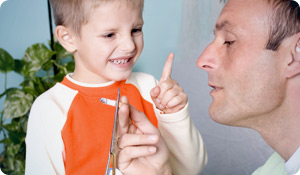
See what people are saying about this article on our Facebook page!![]()
We know that smoking puts us at risk for countless health problems, especially cancer and heart disease. Despite the overwhelming evidence, many parents continue to smoke. In addition to compromising their own health, smoking parents put their children at risk for serious health issues by exposing them to secondhand smoke.
The smoke one exhales or the smoke from a burning cigarette are the two sources of secondhand smoke (also called passive or involuntary smoking). Secondhand smoke has more than 250 chemicals known to be toxic or carcinogenic and causes more than 3,000 lung cancer deaths annually. Living with a smoker increases a non-smoker's risk for lung cancer by 20 to 30 percent.
Sadly, adults expose about 60 percent (22 million) of American children to secondhand smoke, much of it in their homes or cars. One-third to one-half of all children live in homes where secondhand smoke is prevalent. In fact, kids are exposed to more secondhand smoke, on average, than nonsmoking adults. This is particularly true in lower-income families where parents may not be as aware of the dangers of secondhand smoke.
Secondhand smoke is one of the most common toxic environmental exposures children face and they have little control over it. Children's bodies and brains are still developing so they are more vulnerable to health problems caused or exacerbated by exposure to secondhand smoke. They also have smaller airways and greater oxygen demands.
Studies have linked secondhand smoke to a litany of physical and mental health problems:
- Coughing and wheezing
- Bronchitis
- Asthma
- Pneumonia
- Respiratory tract infections
- Eye and ear problems
- Sleep disturbances
- Lower birth rates
- Poor mental health, especially hyperactivity and conduct disorders
Furthermore, babies exposed to secondhand smoke are more likely to die from Sudden Infant Death Syndrome (SIDS) and early exposure may be associated with the development of cancer later in life.
It doesn't take long for secondhand smoke to wreak havoc. In a study of secondhand smoke exposure in children riding in cars, researchers found that if someone smokes a single cigarette for only five minutes it causes alarmingly elevated levels of respiratory suspended particles (RSP) and a significant increase in carbon dioxide in the child.
The U.S. Surgeon General says there is no risk-free level of secondhand smoke and the only way to protect children is by maintaining 100 percent smoke-free environments.
Give your children the gift of a smoke-free childhood.
See what people are saying about this article on our Facebook page!![]()
Sources:
Brauser, Deborah. "Secondhand Smoke Exposure Linked to Mental Disorders in Children." Medscape Medical News. Web. 15 December 2010.
http://www.medscape.com/viewarticle/734309
Campaign for Tobacco-Free Kids. "Harm to kids from secondhand smoke." Web. 9 September 2010.
http://tobaccofreekids.org/research/factsheets/pdf/0104.pdf
Kids Involuntarily Inhaling SecondHand Smoke. Web.
http://www.kiiss.org/
Rees, Vaughan, W. PhD, and Connolly, Gregory N. DMD, MPH. "Measuring Air Quality to Protect Children from Secondhand Smoke in Cars." American Journal of Preventive Medicine 31(5) (2006): 363 - 367. Web.
http://www.hsph.harvard.edu/academics/public-health-practice/files/REES_AJPH_car_study_2006.pdf





